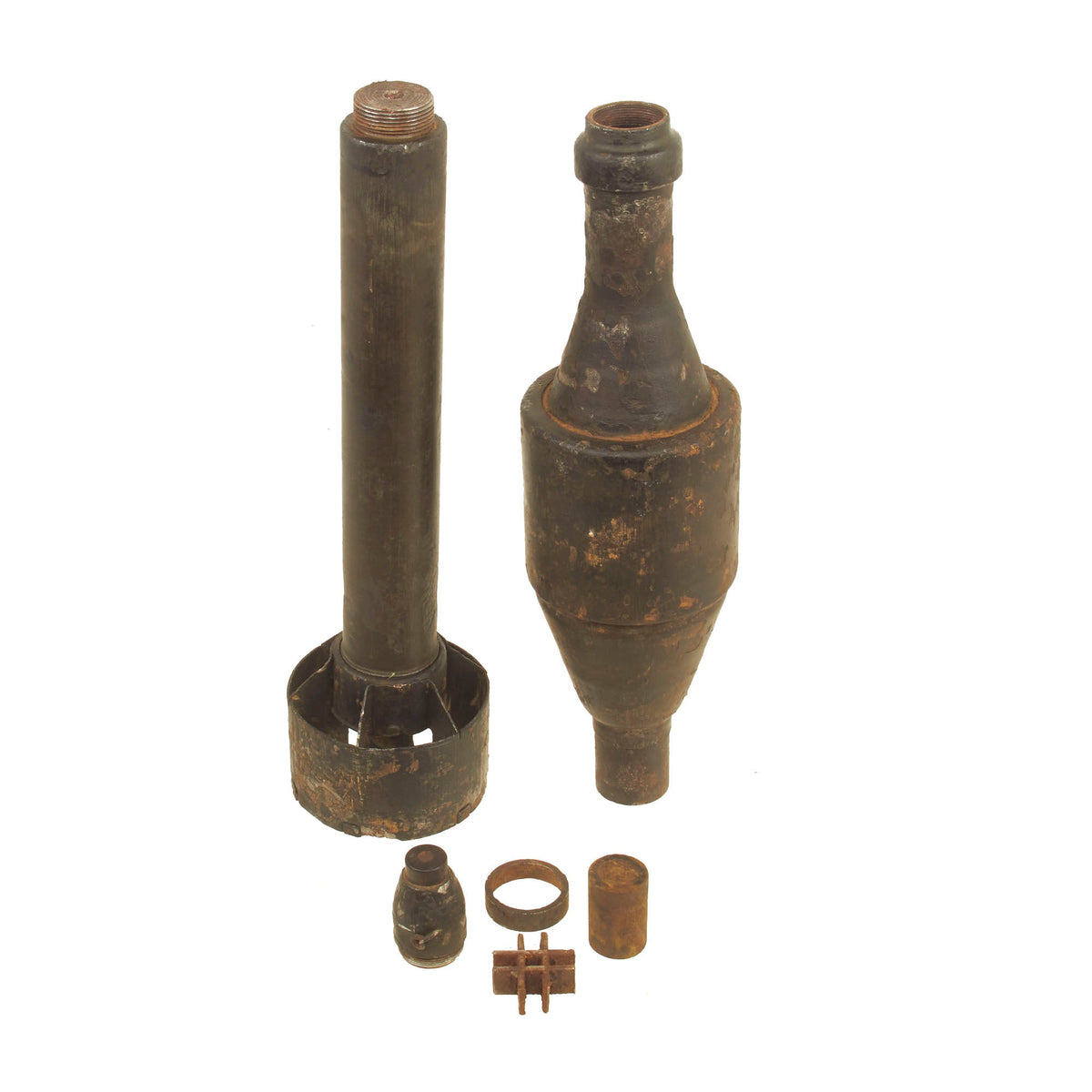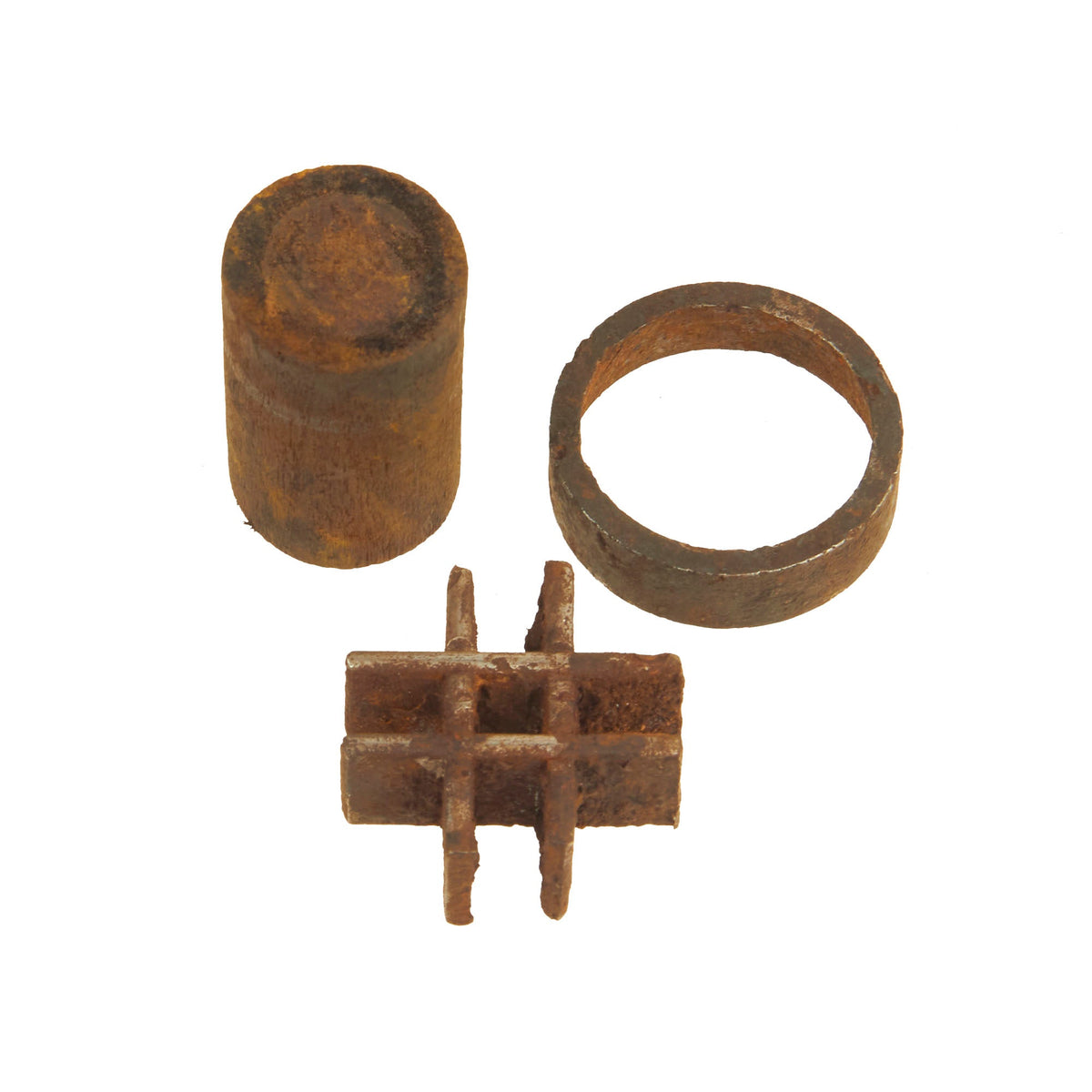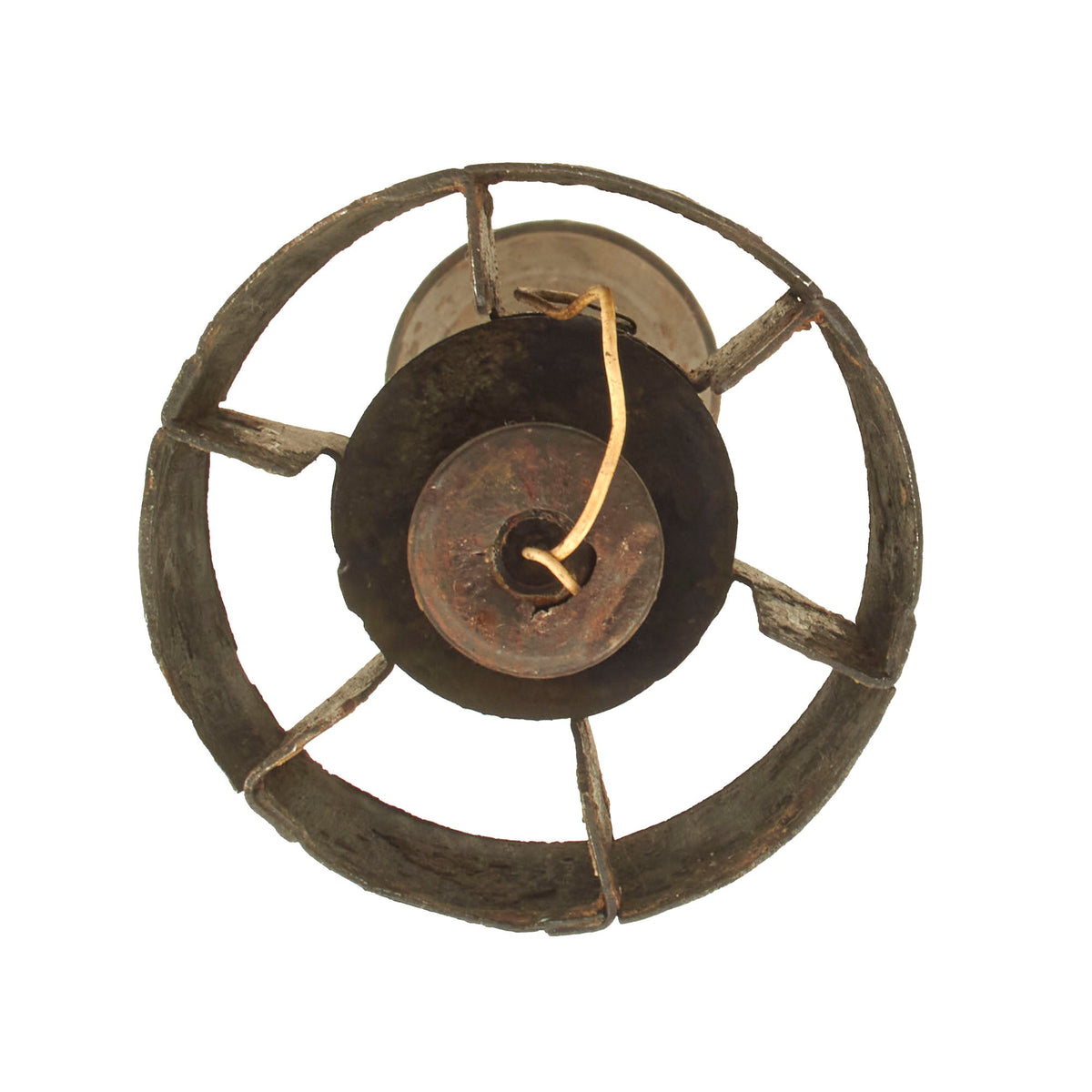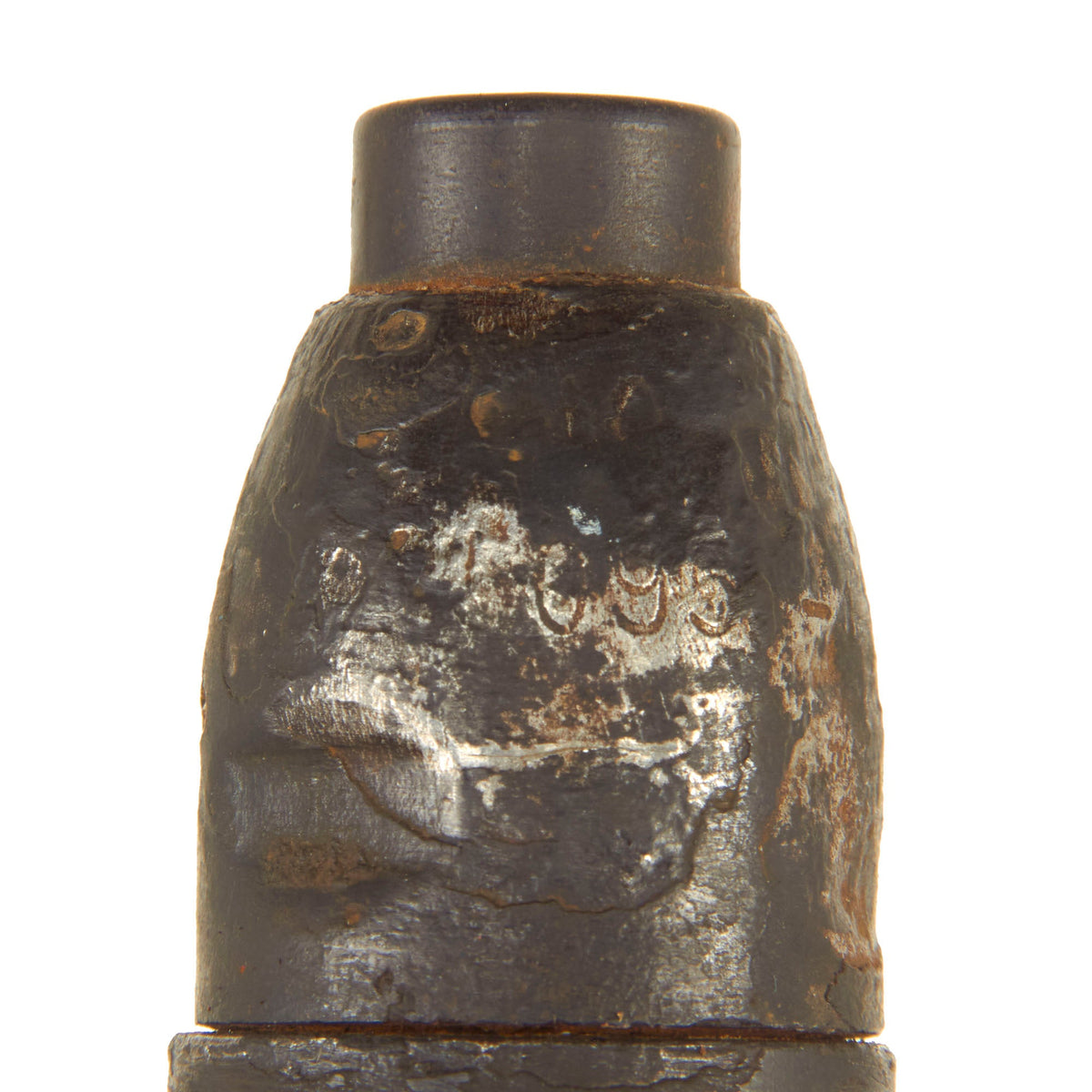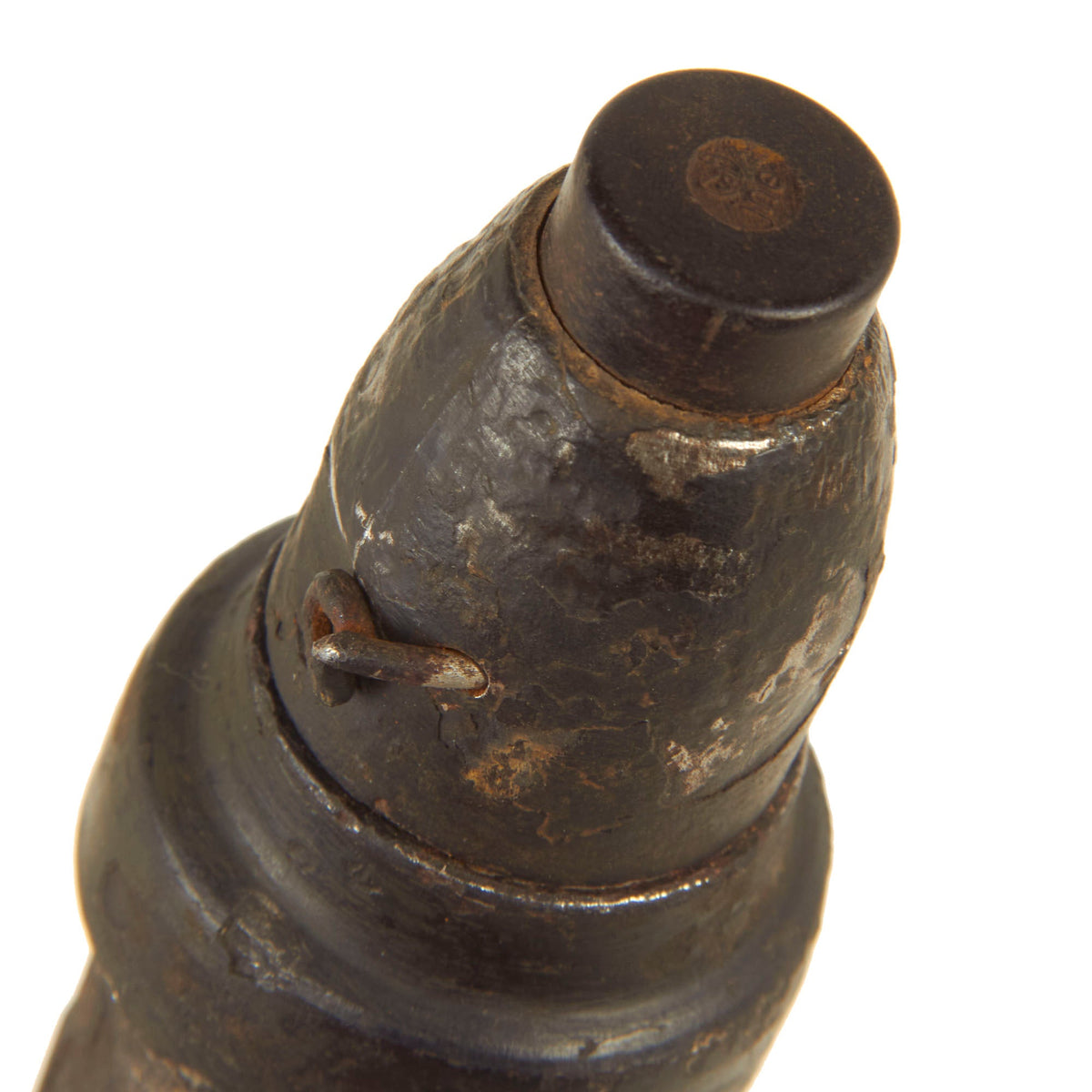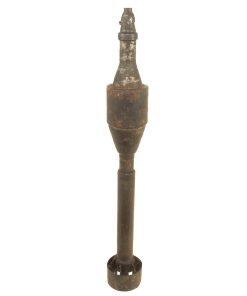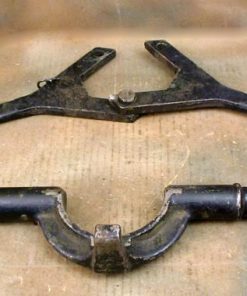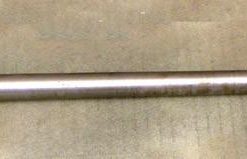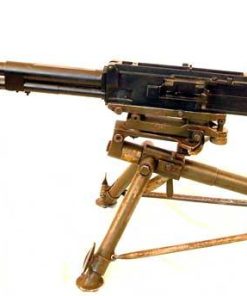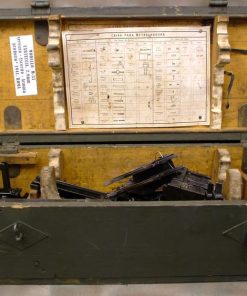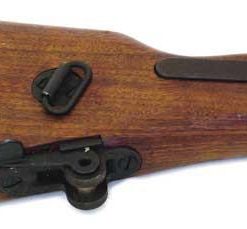Original German WWII Inert Panzerschreck RPzB 54 Anti-Tank Rocket with Extras Original Items
$ 1.395,00 $ 348,75
Original Item: Only One Available. This is a genuine inert Panzerschreck RPzB.54 rocket offered in very good condition. The exterior shows wear and some past oxidation, but this does not look to be a “ground dug” example. All the rocket body details are complete and solid such as the tail fin and head, it even has the original bakelite fuse top button. The rocket measures 26 inches overall, and still unscrews into several components: motor, warhead, and fuse. It also comes with some extra components left over from dimilitarization, and what looks to be the original wooden top plug for the warhead, which would be in place prior to fuse installation. There is even still the cap on the base of the motor nozzle!
The very top of the fuze is marked jne, for known fuse and ordnance maker Presswerk Mollberg & Co., located in Hofgeismar Bez. Kassel. There is also a very faint Waffenamt Eagle on the top of the motor, seen when unscrewed, though it was stamped lightly and the inspector code is illegible.
Panzerschreck rockets are much harder to find than the launchers and this original; wartime example is sure to fill a hole in many collections, especially in such nice condition!
The rocket itself is totally inert and is unable to be used as a destructive device. All explosive content has been removed from the rocket and it is in total compliance per the current BATF regulations governing ordnance.
Not Available For Export.
History of the Panzerschreck RPzB.54:
The RPzB 43 Panzerschreck (Tank Terror) was an enlarged version of the U.S. M1 Bazooka being scarcely more then a length of steel tube with a shoulder rest and firing arrangements attached, hence the alternative German nickname of Ofenrohr (Stovepipe). The caliber was selected simply because 88mm hollow charge warheads were already in production for launching from the R-Werfer 43 but with rockets for the RPzB 43 there was a difference. Having noted that the American M6 HEAT rocket was ignition method was altered accordingly, resulting in the RPzBGr 4322 weighing 3.25kg (7.2lb). However the Germans decided not to adopt the battery-powered ignition circuitry rapidly developing and adopting a magneto-driven ignition method. It is interesting to note that the Americans later adopted a magneto ignition system for their
M9/M9A1 launchers.
The unexpected advent of the M1 Bazooka in Tunisa made a considerable impact on the German military establishment. Not only did the Bazooka concept present a considerable danger to German armor but the simplicity, low cost and potential of the launchers design made a great impression. The immediate result was the abandonment of the R-Werfer 43 in favor of the novel Bazooka rocket delivery system. Within weeks the first examples of the 88mm (3.4in) Raketenpanzerbüchse43 (88mm RPzB 43) were coming off the HASAG production line at Meuselwitz. Most R-Werfer 43’s already produced were sent to Tunisia or Italy and were soon forgotten or lost in action. Many were diverted and placed among the defensive works covering the Normandy beaches as part of the Atlantic Wall defenses.
The weight of a loaded 88mm RPzB 43 was 9.5kg (20.9lb). Amour penetration performance remained as before ie 160mm (6.24in) of amour plate set at an angle of 60°. The length of the RPzB 43 (1.64m) meant that to handle it effectively called for a team of two, one acting as the loader and carrying five ready-use rockets on a special backpack frame. Only when a target approached was a rocket loaded into the rear of the launching tube where it was held by a retaining catch and connected by the loader to the firing circuit via two thin wires. The firer used simple fixed sights for aiming and cocked the firing arrangements by pulling back a spring-loaded lever. Operating the trigger produced a current for a primer to ignite the rocket motor and launch the rocket.
RPzB 43 teams had to be masters of concealment and stealth for the practical range of the RPzBGr 4322 rocket was a maximum of 150m (492ft). Combat ranges were frequently considerable less. A trained team could launch four or five rockets in one minute. Panzerschreck warheads were also highly effective against field fortifications or buildings during fighting in built up areas.
The RPzB 43 was very rapidly accepted into service and soon became the preferred portable anti-tank weapon for infantry formations. By 1944 the weapon was so well integrated that each infantry regiment had an establishment of 36 held by the regimental anti-tank company, along with three 75mm (2.9in) Pak 40 towed anti-tank guns. The so-called Volksgrenadier infantry regiments of the latter war years were meant to have a planned 72 Panzerschrecken.
By mid-1944 the RPzB 43 was well into the process of being withdrawn from front line units in favor of the improved 88mm (3.4in) RPzB 54. The RPzB.54 Panzerschreck antitank rocket launcher differs from the Ofenrohr primary by addition of the protective steel shield with aiming glass window, which protects shooter’s face and hands from rocket back blast. Another improvement is more elaborate sight, which allows for better windage, temperature and range adjustments, as well as the addition of 4 steel flutes which run the length of the barrel and increased strength.
By 1944 the Panzerschreck series had already become so important that production was in progress in seven centers and many others were concerned with sub assemblies. The simplicity of the RPzB 54 and its lack of demand for critical raw materials or manufacturing resources were such that it became an integral weapon in the German effort.
Specifications: German WWII Panzerschreck, Raketen Panzerbüchse 54
Caliber: 88.9mm
Action: Electrically ignited solid rocket fuel propellant
Crew: 2
Range: 150 yards
Weight of Round: 7 lbs 4 oz shaped charge
Armor Penetration: 4 inches armor plate
Overall Length: 64 inches
Weight: 20 lbs 4 oz
Fast Shipping with Professional Packaging
Thanks to our longstanding association with UPS FedEx DHL, and other major international carriers, we are able to provide a range of shipping options. Our warehouse staff is expertly trained and will wrap your products according to our exact and precise specifications. Prior to shipping, your goods will be thoroughly examined and securely secured. We ship to thousands clients each day across multiple countries. This shows how we're dedicated to be the largest retailer on the internet. Warehouses and distribution centres can be located throughout Europe as well as the USA.
Note: Orders with more than one item will be assigned a processing date depending on the item.
Before shipping before shipping, we'll conduct a thorough inspection of the items you have ordered. Today, the majority of orders will be delivered within 48 hours. The delivery time will be between 3-7 days.
Returns
The stock is dynamic and we cannot completely manage it because multiple stakeholders are involved, including our factory and warehouse. So the actual stock may alter at any time. It's possible that you may not receive your order once the order has been made.
Our policy is valid for a period of 30 days. If you don't receive the product within 30 days, we are not able to issue a refund or an exchange.
You can only return an item if it is unused and in the same state as the day you received it. You must have the item in its original packaging.
Related products
Uncategorized
Australian WWII Owen MK1 Machine Carbine SMG Custom Fabricated Replica with Sling Original Items
Uncategorized
Uncategorized
Uncategorized
Uncategorized
Uncategorized
Band of Brothers ORIGINAL GERMAN WWII Le. F.H. 18 10.5cm ARTILLERY PIECE Original Items
Uncategorized
Uncategorized
Uncategorized
Uncategorized
Uncategorized
Angolan Rebel 1970s era 60mm Inert Display Mortar from Angolan Civil War Original Items
Uncategorized
Uncategorized
Uncategorized
Uncategorized

